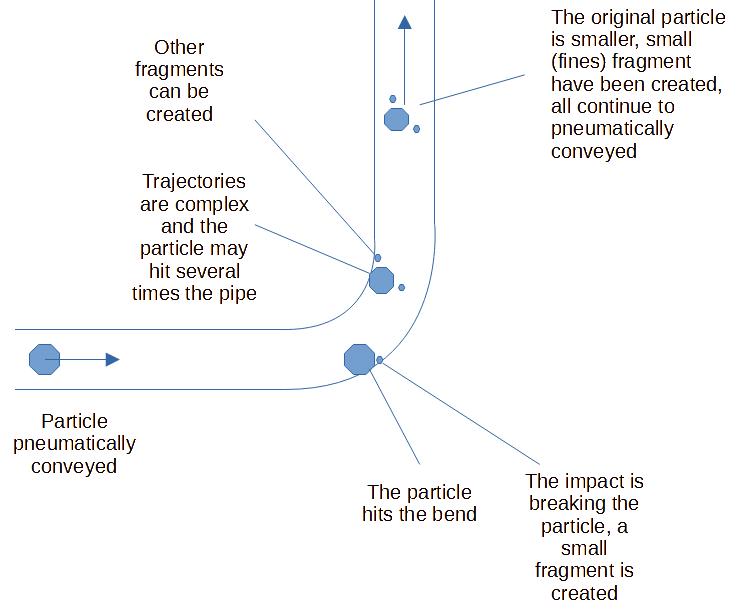
Powder breakage, particle attrition and pipe wear
Why are powders damaged in pneumatic conveying systems
How to avoid powder breakage and pipe wear in pneumatic conveying line
Follow us on TwitterQuestion, remark ? Contact us at admin@powderprocess.net
| Section summary |
|---|
| 1. Definition |
| 2. Calculation |
| 3. How to reduce product breakage in pneumatic conveying |
1. Definition
What is powder breakage or solid attrition ? What is pipe wear ?
When a solid is conveying in a pneumatic conveying transport, some of its physical properties will most probably be affected. The most common problem observed industrially is to break the material thus change the particle size distribution PSD of the product being conveyed. Generally large particles will break when the solids is hitting the conveying pipe, especially at bends where the flux of air and product needs to change direction. Because of this attrition, the PSD will be shifted towards smaller particles and fines will be generated. Over long term, if the bulk solids conveyed are quite hard, the breakage of the product may not be the only observation. Pipe wear, which is the a damage of the piping, especially at the bends can happen, as the materials take out progressively small chips of the pipe surface.

2. Calculation
How to estimate the breakage of a powder ?
The product breakage can be fully characterized by measuring the PSD of the material before and after transport. This PSD can be simply gathered through sieving or thanks to more complexed and precise methods like laser diffraction. However, industrially, a very quick estimation of the impact of the transport on the solid can be done by measuring the bulk density - tapped - before and after the transport. The more the bulk density increases, the more the breakage.

Equation 1 : calculation of solids breakage
With :
- d1 = tapped bulk density of solids BEFORE transport (g/l)- d2 = tapped bulk density of solids AFTER transport (g/l)
- Breakage in g/l (shortcut characterization)
Top
5 Most Popular
1.
Pneumatic transport design guide
2. Ribbon
blenders
3. Powder mixing
4. Hoppers design guide
5. Measuring degree of
mixing
--------------
 --------------
--------------
Top 5 New
1.
Continuous Dry Mixing
2. Mixing speed
3. Mixer cycle time optimization
4. Batch / continuous mixing
comparison
5. Energy Savings
3. How to reduce particle breakage in pneumatic conveying lines
There is no typical value of breakage nor can it be calculated a priori. Trials should be carried out to estimate it. Now the attrition is directly linked to the impact of the solids towards the conveying pipe, thus it can be reduced and controlled by applying the following measures :
- Reduce the conveying velocity. In design, the conveying velocity should be minimized and confirm through pilot plant trials. For existing installation, it is often observed that the conveying velocity is way above its optimal, it is then possible, if the blower is on VFD, to progressively correct the air flow rate, observing the behavior of the line, and find an optimum.
The conveying velocity is the key factor contribution to particles breakage but also pipe wear. The following general relation is often given to model how pronounced will be the erosion of a pipe : [1]
Erosion = k.(particle velocity)n
Equation 2 : estimation of the pipe wear
k is a constant while n is often found in between 2.2 and 2.8. Now consider that you can decrease the conveying speed by 10%, then 0.9 to power 2.2 will give you a rate of erosion decreasing by 20%. On the other direction, if you convey too fast by 25% versus the optimal which is very common, the increase of erosion will be ... 63% ! Of course, reducing the erosion will also reduce the particles breakage. Conveying at the optimum speed if thus very important.
- If possible, switch to dense phase conveying, which offers significantly lower air conveying velocity compared to dilute phase.
- Reduce the number of bends, especially in dilute phase. Bends are the main contributor to product breakage and every bends avoided will save the product from damages. At design stage, it is sometimes better to consider a slightly longer pipe layout but with less bends, rather than having a short pipe but turning around every equipment.
- Change the bend type. For some application, specific designs of bends can be chosen which are reducing the impact force and thus the breakage. Long radius bends are a solution, although not always the most efficient, while designs creating a layer of product in the bend, on which the product will softly impact, are generally quite efficient.
It is also important to note that particle degradation is sometimes coupled with pipe wear, with the pipe getting damaged due to the impact of the particles on the bends especially.
Sources and other references
[1] SHAPA techical paper 5, 2002